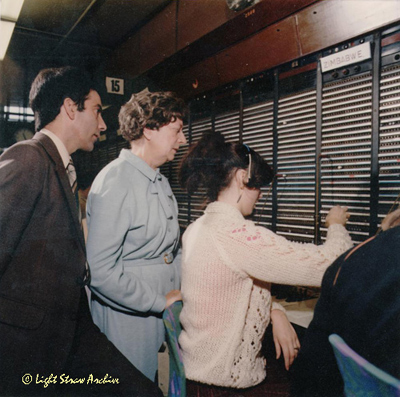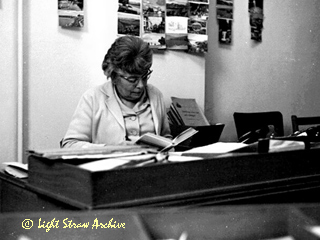 |
Malcolm Knight recalls just some of his time in telecommunications... |
The Early Years
Malcolm Knight began working for the GPO in December 1962 and was appointed to City Telephone Area in London. After initially assisting the managers of Bishopsgate, Monarch, Royal, Shoreditch and Waterloo automanual centres (AMCs) he was appointed at the young age of 19 to be Exchange Superintendent at Avenue AMC in East Cheap London EC1, taking over from Jack Coombes.
Avenue AMC
 |
Avenue AMC |
Directory Enquiries, which town please?
In the mid-sixties, Malcolm moved to Directory Enquiry work (in Camelford House) with responsibility for all the dozen or so large and small DQs, dotted around the London Telecomms Region, and the Flexocopy Unit producing directories and exchange VIFs. This was an interesting period encompassing the introduction of the Initiative Operating Procedure whereby "Directory Enquiries, can I help you?" was replaced with "Directory Enquiries, which town please?".
This period also saw the introduction of the first computer produced telephone directories and early experiments with microfiche retrieval systems.
Malcolm could appreciate the value of site visits to aid his management of the DQ units from his regional office. He would often drop into an exchange, and don a headset, to experience any problems in operating procedures at first hand. However, even in the liberating Sixties, the management structure in the Civil Service run Post Office had strict rules about how business should be conducted, and it was not the done thing to be too familiar with operating staff. Thus after a dispute with a boss some three ranks above him, who insisted he must manage the work remotely from his own office, Malcolm was drafted into the External Telecommunications Executive (ETE).
Telecommunications Instructions (TIs)
From 1975 to the end of 1978 Malcolm wrote, from his office in HQ, the TIs (Telecomms Instructions) relating to the practices and procedures of connecting and charging calls over the wide variety of systems in use. The ISOCC (Input System for Operator Controlled Calls) had just replaced the MATS system for Inland calls in 1973 and Malcolm's appointment was to extend the TIs to cover the call billing of International services. As a consequence, he was faced with the tedious job of inputting call tariffs into the new computer system (a period of high inflation saw them increased every three months) plus the infinitely more interesting one of writing the operating instructions for international telephone operators.
In 1977 a further revision of the operating instructions was needed to cater for the new Marisat satellite service to ships at sea. The unions were particularly strong during the Seventies and any change in working practice had to be agreed with them, otherwise an all out strike might well have been the result. At the time only the QEII was so equipped for the new service, and the local exchange management had better things to do than persuade the unions to accept a service which they didn't see as a priority.
Malcolm didn't see this as a problem; on the contrary, it was a good excuse to get out into the exchanges to demonstrate just how straightforward the new procedure could be to implement. Using his 'people skills' * he spent two consecutive nights at the Faraday switchboard showing the local staff that Marisat calls were easy and fun to connect. The service slipped in almost unnoticed.
* He sought out the union officials in their favourite watering hole and bribed his way into the exchange with beer.
As the whole set of operating instructions was by then entirely revised and reissued, the Marisat episode persuaded him to seek a new appointment closer to where the real work went on...
Faraday 2A
...And he was sent to Faraday 2A to shut it down within six months!
Nonetheless, he adopted a fresh approach to the onerous task of managing a large switchroom and his previous background knowledge of procedures enabled him to quickly devise new duty rosters. Keen to listen to the staff and improve the service, he worked long hours, undertaking a detailed study of the exchange, which highlighted a deficiency in the number of circuits. He was able to justify the provision of additional circuits and as a direct result (and partly to his surprise) productivity in the unit increased more than twofold.
Inevitably, the planners caught up with the increased productivity and the end had to come. Eighties technology was bringing with it new ideas for the optimum size of switchrooms, their locations, and how they should be managed.
Wren House (1981-1984)
Faraday 2A closed in May 1981 and most of the work was transferred to Wren House next door. Malcolm went with it along with a high proportion of the 2A staff. However, with a staff approaching 1,300, it could never be such an intimate environment as 2A, but in spite of this, the productivity rose to be on a par with the best that International Telephones could then offer.
Statistics carried much weight with senior management, and to fit Wren House into the national format, the exchange had to be divided into 28 separate sections. Producing all those statistics was an extremely onerous task leaving little time for niceties such as annual leave.
In an effort to alleviate this problem Malcolm obtained one of the first desktop computers in the whole of British Telecom International (which was contrary to ITp rules at the time) and since no suitable software* was available, he and Fred Dowry spent six months of evenings and weekends teaching themselves how to program the machine. This was widely seen as a total waste of valuable resources until the time taken to produce Wren House's statistics suddenly tumbled from more than three man weeks a month to less than two man hours.
* This was real programming code, no Excel or Access around back then!
Computerised Stats
After that there was pressure to install computers and suitable programming at all the ICCs (International Control Centres) so Malcolm somewhat reluctantly went off to do that. Because of the initiative taken in Wren House the International exchanges were fully computerised some years before they made an appearance in Inland exchange traffic offices; quite an achievement!
The Final Mission
The computerisation continued until the task was finished in 1988. With many London Operator Assistance Centres either closed or closing Malcolm switched to doing something entirely different.
Management had come full circle. After the very restricted Civil Service way of running the business there followed sweeping changes which, over the years, had abolished several layers of management. Now, to meet modern quality control measures, every job had to be specifically defined by a Mission Statement.
Malcolm found that writing Mission Statements for senior managers was a far cry from the very challenging times of 'hands on' management of a busy switchroom and so he 'escaped' from British Telecom to lead a normal life.
For earlier days in Malcolm's life then visit www.f-g-s.co.uk/
Page last updated 19th September 2012.Checked May 2021.
All logos and trade marks are the property of their respective owners and are used on the Light Straw site(s) for review only. Students and researchers are recommended to make their own independent enquiries as to the accuracy of the information contained therein.